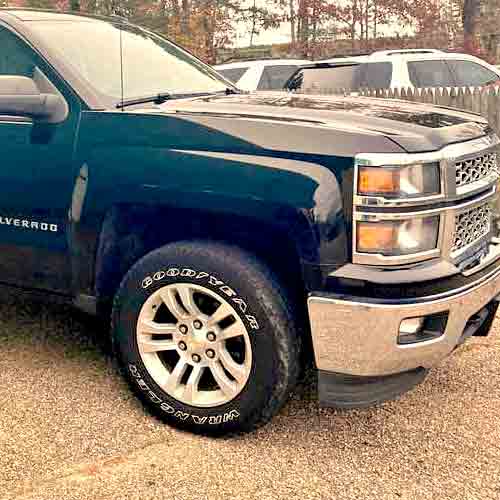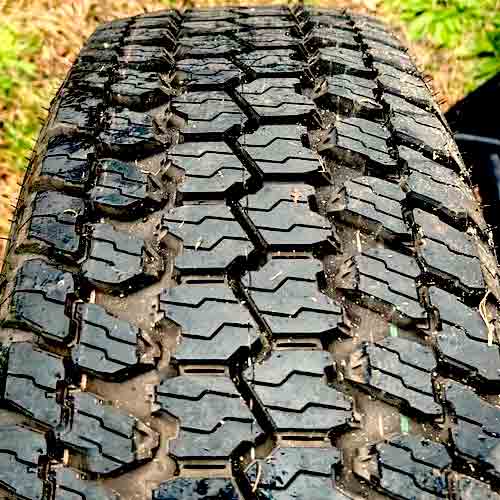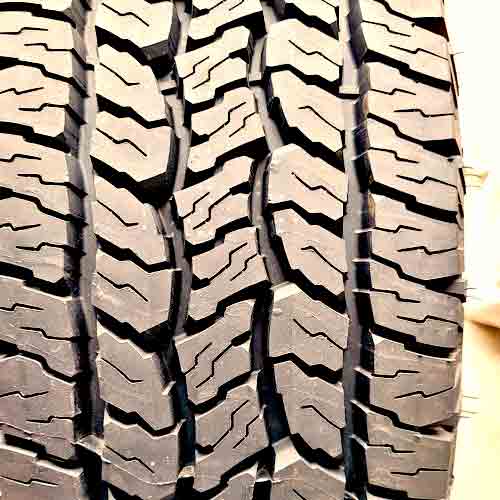Both the Goodyear Wrangler AT/S and the TrailMark are a great choice for those who are looking for a tire that provides a great balance between on-road comfort and off-road traction. They are equipped with innovative tread compounds and ample biters that offer superior performance in all conditions.

Key Takeaway
So the main takeaway here is this: the Goodyear Wrangler AT/S comes out better in wet and winter performance, and the tire is relatively superior with traction on sand, rock and mud traction, even though both tires are not that aggressive. In comparison, the Goodyear TrailMark comes out on top in overall on-road areas, delivering superior dry grip, fuel economy, tread life and comfort.
Note: If you haven’t yet, check out the list of top A/T tires, PS, these two tires didn’t make it to the list.
Available Sizes
On the other hand, the Goodyear Wrangler A/TS comes in 15 to 20 inches with following specs:
- Speed ratings: R and S.
- Load ratings: SL, C, D and E.
- Weight range: 30 to 60 lbs.
- Tread depth: 13 to 16/32″.
- Ratings: No 3PMSFR.
- Warranty: None.
The Wrangler TrailMark on the other hand, has following specs.
- Sizes: Only available in 16 and 17 inches rims.
- Speed ratings: S and T.
- Load ratings: SL and XL.
- Weight range: 27 to 47 lbs.
- Tread depth: 11 and 12/32″.
- Tread warranty: 55k miles.
- Winter ratings: None.
Tread Features
Both tires from Goodyear are equally aggressive, though they both feature very unique tread designs. Let’s start with Wrangler A/TS.

So this tire comes with very closed up ribs placement in the middle.
These ribs form very narrow groove in between, especially compared to outer wider channels.
With closed up central section, highway grip is achieved, while the outer ensures self cleaning on rugged paths.
All these lugs carry a lot of tread features, including interlocking sipes, and off-set edges.
Moving towards shoulder lugs, (considering both outer ribs), you see similar tread features.
Moreover, these lugs don’t have staggered outer edges, and you also don’t get any sidewall lugs with this tire.
The Wrangler TrailMark on the other side, although offers similar 5 rib design, there are a few things different here.

Let me start form the middle on this tire as well.
Here 3 ribs are seen; the middle most has blocks with notches facing sideways, and sipes connecting to them.
All of these lugs are attached to each other longitudinally.
The surrounding ribs have blocks running in pairs, (both blocks are sitting on reinforced foundations, made with secondary rubber underneath).
They have sharp chamfered edges, off-set sides and thick full depth interlocking sipes.
Moving towards the shoulders, the blocks are bigger, and very packed up here as well. All of them are sitting on continuous running rubber layer underneath, they make a very stable contact with the ground.
Moreover, these lugs are not staggered (on the outer edges). And the tire is also missing with sidewall lugs, just like the Wrangler Adventure.
Road Noise
Although all-terrain tires, and on-road quietness don’t belong in the same sentence, some on-road oriented A/Ts still provide a decent job, and both these boys here are in that list.
But still out of them, the Goodyear TrailMark shows up with 2 decibels quieter on average (across all speeds on highways).
The tire basically is less voided towards the outer edges of the tread, from where most of the air comes in, and hits around, creating noise.
Whereas, if you consider the tread of Wrangler ATS (scroll up to the tread appearance section), you’d note that it’s balder and therefore louder.
Dry Traction
Dry traction depends on a lot of variables, including overall tire’s structure. And considering them, it can be explained why you get to see a better performance on Goodyear Wrangler TrailMark.
It comes with a lighter structure, stiffer composition, lower tread depth, and closed up tread voids. Let me explain how each of these contribute.
By weighing less, the tire does not create as much inertia, and combined with it’s stiffer compound, its lugs stay firmer with the road, resulting in quicker steering response.
This is also further aided by the tire’s shallower tread depth, as with that, lugs don’t get to bend as much as the tire corners, or brakes, resulting in a more direct steering.
Moreover, its greater footprint contacts the road more, compared to Wrangler ATS, and naturally results in superior grip.
Wet Traction
Wet traction can be enhanced by addressing two crucial elements: grip and hydroplaning resistance. Let’s take a look at what’s going on with each of them.
Wet Grip
A tire that incorporates siping and flexibility in the tread is essential for optimal wet road grip. These two traits work in tandem to clear water efficiently.
Basically sipes are just slits and they “flex” to create suction for the water particles, which are then wiped off, so the tread can “grip” in.
That’s why with greater number of siping, the Wrangler ATS is taking the lead here.
The Goodyear TrailMark on the other hand, not only lacks in delivering as many sipes, but you also a more rigid tread compound here. So sipes face a harder time in contacting/expanding, limiting overall grip.
Hydroplaning
Ineffective water evacuation from a tire’s tread can lead to aquaplaning or hydroplaning, and to avoid that tires use grooves to channel that water out.
Basically most of the water leave out through these grooves, while the rest is dealt with sipes (like I explained in the section above).
That’s why the Goodyear TrailMark with a relatively less-voided structure can’t throw water out as quickly as its counterpart.
Tread Life
When both tires are form same company, you can easily find out which tire would last longer just by looking at their Uniform Tire Quality Grade or UTQG.
And in case of both these tires, it’s better on Goodyear TrailMark. The tire comes with 560 treadwear rating, whereas the Wrangler ATS comes with only 360.
So why is that? Well because the TrailMark has a lighter structure, and it puts less pressure on its tread blocks, as the rub against the surface.
So it makes sense why Goodyear gives 55k miles warranty on this tire, whereas the ATS doesn’t come with any.
Fuel Consumption
Like I explained in the tread life section above, the Goodyear TrailMark shows up with lower rolling resistance values, because of it’s lighter weight, it also makes sense why the tire is better with fuel as well.
It’s superior fuel economy has to do with its closely arranged lugs placement, especially towards the shoulders. It’s circumferential grooves aren’t that wider and so lugs get to have a more evenly distributed weight on themselves.
Winter Traction
Both tires although lack in holding sever winter ratings, even with their all season tread compound, the Goodyear Wrangler A/TS still offers a better traction.
It’s sipes are better optimized for snow, and its voided structure supply superior snow scooping abilities.
The Goodyear TrailMark basically makes greater rubber to snow contact, which is not ideal. This is because on this terrain, you need to form ground contact with the lodged snow particles in the tread voids (as snowflakes stick better on each other).
Off Road Traction
Off-road, I tested these tires in the following terrains. Let me discuss each one by one.
Thick Mud
A tire with wider grooves and self-cleaning abilities is what you need on this type of terrain. And although I don’t recommend taking these tires on deeper tracks, out of them, at-least the Goodyear Wrangler ATS gets to be gripping on lighter terrains.
The tire comes with larger tread depth which allows greater volume of mud to escape out at a given time.
And it’s wider outer tread area supplies superior mud evacuation, in comparison.
Rocky Trails
Rocky terrain require tires having both lateral and vertical gripping capability, and although both tires lack in providing much of it, you are still better off here with Goodyear A/TS.
The tire at least offers bigger groove mouth to bite in to the rocky surface, with it’s relatively more voided structure.
Moreover, it’s full depth sipes, also helps in splitting open the lugs, as they try to chew on the rocky surface.
On Sand
Sand traction has a lot to do with weight and tread composition, that’s why the Goodyear TrailMark featuring a lighter overall structural weight, and a more pliable compound does better.
By weighing lighter, it does not want to dig in too much, whereas it’s softer compound helps it mold better with the sand with lowered air pressure.
Wrangler ATS on the other side, not only comes with a rigid tread composition, but it’s sharper sides are more susceptible in to digging, rather than focusing on moving forward.
Verdict?
Goodyear Wrangler AT/S, is although slightly more aggressive than its counterpart, the tire still manages to supply you with superior wet and winter performance (on pavements).
And of course, off-road it’s definitely a much better pick, as it offers much nicer rocky, muddy and sandy terrain traction.
The Goodyear TrailMark on the other hand, does great when it comes to dry highway grip, steering response, and it’s fuel economy, tread life, and comfort is also ranking better as well.